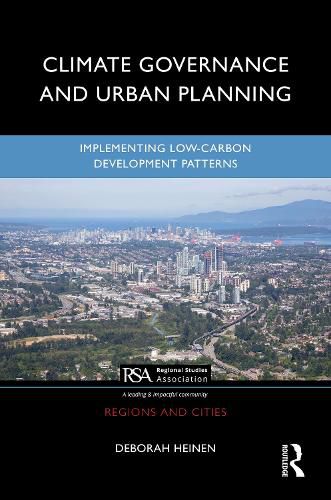Readings Newsletter
Become a Readings Member to make your shopping experience even easier.
Sign in or sign up for free!
You’re not far away from qualifying for FREE standard shipping within Australia
You’ve qualified for FREE standard shipping within Australia
The cart is loading…






Urban planning as a discipline is deeply integral to implementing a low-carbon future. This book fosters an understanding for the rules-in-use that govern urban planning and influence the ability to implement low-carbon development patterns. Drawing on the theoretical foundations of the climate governance and urban planning literatures, the book provides a context to understand plan implementation challenges and obstacles in metropolitan areas.
A particular planning challenge in metropolitan regions is examined in depth as an example to understand the polycentric nature of taking climate actions: The challenge to implement transit-connected urban centers. As metropolitan regions across the globe seek to reduce emissions from transportation, many levels of governments have developed ambitious climate action plans that make land use and transportation recommendations in order to reduce vehicle miles traveled. Many have recommended low-carbon development patterns which are characterized by intensified and diversified uses around rapid transit stations. However, the implementation of these recommendations is done within the context of different rules-in-use unique to the planning systems in the metropolitan region. The book examines the rules-in-use around the many actors involved in implementing low-carbon development patterns in three metropolitan regions of similar demographic size. By examining the implementation of low-carbon development patterns, the book focuses on growth management related questions about how to coordinate transit investments with land use decisions in metropolitan regions. The book finds that state legislation that deals with metropolitan planning and regional growth strategies can greatly aid in creating accountability among actors as well as provide a road map to navigate conflicts when implementing low-carbon development patterns.
By focusing on the rules-in-use, the book is of interest to policy makers, planners, advocates, and researchers that wish to assess and improve the odds of implementing low-carbon development patterns in a metropolitan region.
$9.00 standard shipping within Australia
FREE standard shipping within Australia for orders over $100.00
Express & International shipping calculated at checkout
Urban planning as a discipline is deeply integral to implementing a low-carbon future. This book fosters an understanding for the rules-in-use that govern urban planning and influence the ability to implement low-carbon development patterns. Drawing on the theoretical foundations of the climate governance and urban planning literatures, the book provides a context to understand plan implementation challenges and obstacles in metropolitan areas.
A particular planning challenge in metropolitan regions is examined in depth as an example to understand the polycentric nature of taking climate actions: The challenge to implement transit-connected urban centers. As metropolitan regions across the globe seek to reduce emissions from transportation, many levels of governments have developed ambitious climate action plans that make land use and transportation recommendations in order to reduce vehicle miles traveled. Many have recommended low-carbon development patterns which are characterized by intensified and diversified uses around rapid transit stations. However, the implementation of these recommendations is done within the context of different rules-in-use unique to the planning systems in the metropolitan region. The book examines the rules-in-use around the many actors involved in implementing low-carbon development patterns in three metropolitan regions of similar demographic size. By examining the implementation of low-carbon development patterns, the book focuses on growth management related questions about how to coordinate transit investments with land use decisions in metropolitan regions. The book finds that state legislation that deals with metropolitan planning and regional growth strategies can greatly aid in creating accountability among actors as well as provide a road map to navigate conflicts when implementing low-carbon development patterns.
By focusing on the rules-in-use, the book is of interest to policy makers, planners, advocates, and researchers that wish to assess and improve the odds of implementing low-carbon development patterns in a metropolitan region.